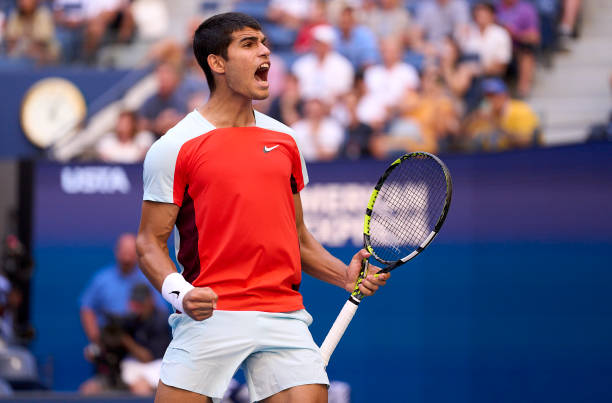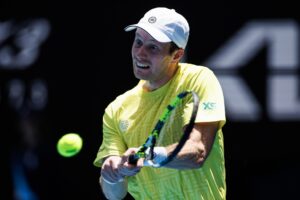The ferocious ball-striking, the unrelenting nature and the slew of broken records of Carlos Alcaraz are bound to draw superlatives and gasps aplenty.
- Rose from #32 at the start of the year to become the youngest year-end world #1 in the Open Era.
- Youngest winner of the Miami Open in the Open Era.
- Youngest major champion since Nadal at French Open in 2005.
- Most time spent on court enroute to a Grand Slam title in the Open Era.
It makes sense for many to view Alcaraz as unstoppable, his ascent to the top of the men’s game seemingly a certainty.
Having studied Alcaraz’ game meticulously however, there is vulnerability to the extreme aggression the Spaniard brings to the court. Alcaraz’s first season at the top of the game didn’t play out with the same nonplussed grace of Roger Federer back in his heyday, neither did it play out with the robotic efficiency of Novak Djokovic in 2011.
Alcaraz won five titles this season. With the exception of Rio, in each of those title runs, Alcaraz’s risky gamestyle left him in at least one sticky situation. Yet he survived those moments, won those matches and won those titles… That’s what defined Alcaraz’s season and set him apart from peers – his ability to come up with his best tennis in the biggest moments.
We review the moments where Alcaraz came back from the brink to earn his silverware this year.
Miami: Quarterfinals vs Miomir Kecmanovic
Miami is where it all started for Alcaraz. He may have won his first ATP title of the season in Rio the month before but the weight of winning a Masters felt far more significant as he beat three top-10 players along the way (Tsitsipas, Hurkacz and Ruud), not to mention defeating a Grand Slam champion in the third-round (Cilic).
Ironically the real test that week came in the form of Miomir Kecmanovic in the quarterfinals. The Serb was in the form of his life covering his second-serve better than anybody else on the tour using a ramped-up version of his otherwise middling forehand.
Though Alcaraz’s serve is sometimes lambasted for its inadequacies, here he showed that aces aren’t everything. After being broken in his first service game, Alcaraz held serve until the end of the match despite only serving five aces over the course of two and a half hours. His heavy delivery frequently set him up for an audacious plus one and, even if his serve didn’t give him an advantage, he came up with some insane shots under pressure.
Watch back: Serving at 4-5 30-30 in the third set, a great half-volley pick-up, down 3-5 in the third-set tiebreak, a ludicrous forehand and drop shot combo.
Jaw-dropping stuff.
Barcelona: Semifinals vs Alex De Minaur
Just like Kecmanovic, Alex De Minaur was playing far beyond his usual expectations. The Australian had always been a fantastic mover but the pace on his shots had often come from his opponent’s racket, making him far more adept on hard-courts. De Minaur was at his patient best however and had put together some fantastic wins on the surface. Against a hitter like Alcaraz, his rally temperament and ability to redirect pace made him an incredibly difficult match-up.
De Minaur soon found himself serving for the match in the second set but was down 0-40. It was too much to overturn as he saved the first break-back point but capitulated on the second to a drop-shot.
Great fightback from Alcaraz but it only seemed to delay the inevitable. Alcaraz would concede the break once more after a six-deuce game – De Minaur wasn’t going to make the same mistake twice and went up 40-15 serving for the match for a second time.
And then it happened. De Minaur approached the net off a forehand to Alcaraz’s backhand. Alcaraz was running so fast to get to the shot he actually overran the ball and as quick as a flash, the Spaniard turned on his heel mid-run to blast a forehand passing shot down the line.
One of the most magical shots of the season. Alcaraz saved the second match point, broke back, won the tiebreak, won the third set and defeated Pablo Carreno Busta in the final to lift his third trophy of the season. Moments like this are what define Carlos Alcaraz’s season.
Madrid: Semifinals vs Novak Djokovic
Those that weren’t believers after Barcelona certainly were after the Madrid Masters. Carlos Alcaraz followed his win over Rafael Nadal in the quarterfinals with a three-set epic against Novak Djokovic before going on to win the title. He became the first player ever to beat Nadal and Djokovic at the same clay-court event. It was everything we expected and more, particularly in the third-set where Alcaraz was forced to come up with every trick in the book to hold serve six consecutive times.
Still, after Djokovic saved a match point down 4-5 and we went to a tiebreak, nobody in their right mind was picking the Spaniard as the favourite. We all feared Djokovic’s revered tiebreak “lockdown-mode”, a refusal to miss that would surely lead to the youngster’s unravelling.
Djokovic asked Alcaraz the question in this tiebreak: “Can you find a way through the wall?”. Alcaraz’s response was emphatic. Up 2-1 in the tiebreak, Alcaraz blasted a backhand winner down the line as his plus one shot. Sound risky? You don’t know the half of it – Alcaraz had used his backhand down the line to win one solitary point up to that point in the match.
That’s one in 257 points.
Alcaraz sensed the need to come up with something special and boy did he deliver.
US Open: Quarterfinals vs Jannik Sinner
With all the other matches to draw on, a Carlos Alcaraz title run surely couldn’t get any more dramatic. Cue the US Open. Alcaraz spends more time on-court than any other Grand Slam champion in the Open Era winning three five-setters in a row and saving set points to avoid a two sets to one deficit in the final.
One of these match in particular however was a microcosm of Alcaraz’s season. His win over Jannik Sinner in the quarterfinal was one of the hardest-hitting matches we’ve ever seen in the latter stages of a Slam, a five-hour epic with both players demolishing the ball.
Though he played some of the flashiest points New York has ever witnessed, he found himself down match point in the fourth set. Two quick flashes of the racket dispatched the threat before Alcaraz broke Sinner’s serve to keep his hopes alive. He broke once again to win the fourth set and raised his level on what should have been an empty tank to win the fifth.
To then follow that win up with a five-set epic against Tiafoe and an extremely tight win over Ruud in the final… Any doubters left, everyone that had watched Alcaraz play and still didn’t believe he belonged where he did – each and every one of them – were converted at that tournament.
Under pressure this season, Carlos Alcaraz showed us he is a different breed.
Main Photo from Getty Images






